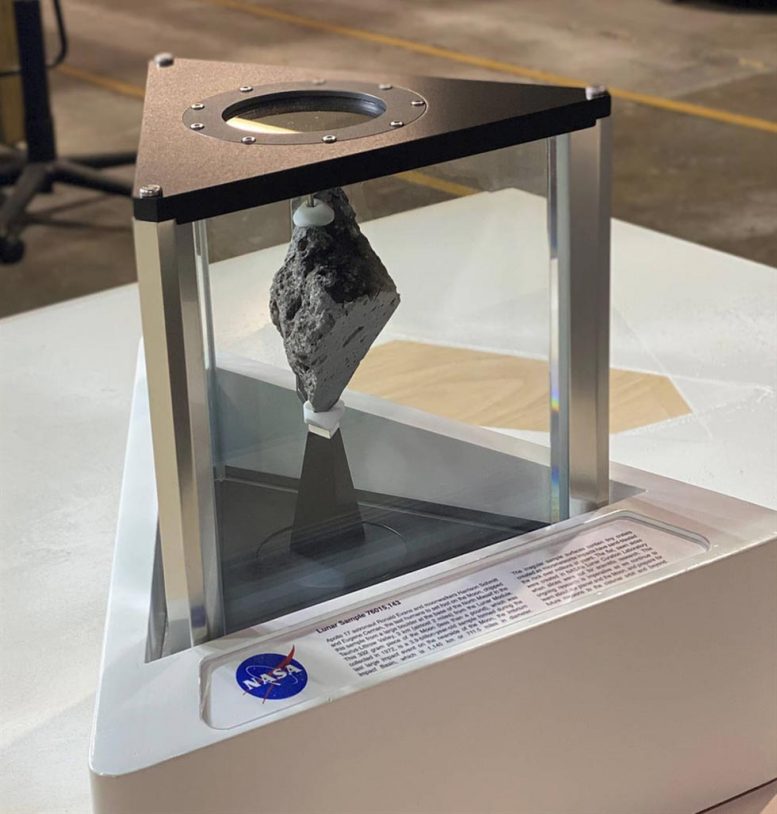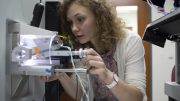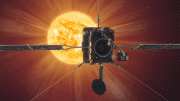
A color composite mosaic showing most of the Moon’s surface, based on images from NASA’s Lunar Reconnaissance Orbiter, photometrically normalized. Credit: NASA/Goddard/Arizona State University
Since the return of the first Apollo lunar samples, or Moon rocks, in 1969, NASA’s Astromaterials Research and Exploration Science (ARES) Division at NASA’s Johnson Space Center in Houston has been responsible for curating all NASA-held materials from another celestial body.
The collection does not end there. Today, Johnson houses the world’s largest collection of astromaterials from the solar system. This includes samples from asteroids, comets, Mars, the Moon, the Sun, and dust from other stars. By curating the most extensive collection of extraterrestrial materials on Earth, ARES provides critical scientific expertise for planetary surface exploration, and leads in the global knowledge of the orbital debris environment.
As the agency prepares for a robotic and human return to the surface of the Moon, the ARES team is providing expertise in sample collection and curation, lunar science research, and lunar surface science mission definition and planning for the agency’s Artemis program. ARES scientists have been responsible for planning and training astronauts for lunar surface activities, and also serve as experts in the analysis and preservation of the precious returned samples.
Here are five things to know about ARES:
1. NASA Loaned a Moon Rock to the White House
A Moon rock managed by ARES is on loan to the White House. The Moon rock went on display in the Oval Office on January 20, and serves as symbolic recognition of earlier generations’ ambitions and accomplishments.
“We chose this sample as a good representation of both the uniqueness of lunar samples, the tiny craters made by micrometeorites that can be seen on one side, and the evidence of scientific research being done on the sample that can be seen in the flat, sawn sides,” said Dr. Ryan Zeigler, ARES lunar curator. Each sample tells us a story but the individual samples within the rock also tell another story. There are 3.95 billion years of history captured through this rock.
2. You Can Explore the Universe with Astromaterials 3D
Some of the ARES collection of Apollo samples along with other arctic meteorites are offered online through a virtual exploration platform called Astromaterials 3D Explorer. This unique platform allows anyone to access them as if they were holding them in their hands. The samples have been captured at 240 angles in a nitrogen cabinet, using super high-resolution photography, and each sample was also scanned using X-ray computed tomography. Not only can each sample be viewed on the exterior, you can also take slices of the rocks to see how they came to be.
“Each sample has its own origin story and you can see that up-close and personal through this innovative platform,” said Erika Blumenfeld, transdisciplinary artist, principal investigator, and project lead for 3D Astromaterials Science at Johnson.
Although 20 samples are in the current catalog, additional samples will be added soon.
3. The First Samples of an Asteroid Collected by NASA Are Heading Home
Orbiting Earth for thousands of millennia in deep space, the asteroid Bennu has witnessed the formation of the solar system. NASA’s Origins, Spectral Interpretation, Resource Identification, Security Regolith Explorer or OSIRIS-REx has been orbiting Bennu since 2018 – with a world record for the smallest body ever orbited – and now, the sample collected in 2020 will begin its journey home to Earth in May. The ARES team began planning for this mission 15 years ago and will be on hand when the asteroid sample capsule will touch down in the Utah desert. The team will have a temporary clean room set up nearby just as they did after the Stardust comet sample successfully landed in 2006. The sample then will be transferred to an ultramodern curation facility now under construction at Johnson. The first scientists to get a look at Bennu will study its chemical and mineralogical makeup to complete the mission’s official science goals. Once studies have concluded, ARES will archive about 75% of the sample to be used in the future by scientists from around the world.
4. Scientists Will Analyze Bennu’s Sample with a New Instrument
Samples returned from Bennu by OSIRIS-REx will enable investigations of organic and mineral components of fresh asteroid samples that experienced neither atmospheric entry nor terrestrial weathering that often hamper studies of meteorites. As Apollo samples helped us understand the Moon, these asteroid samples will shed light on understanding conditions in the early solar system. Soon, ARES personnel will upgrade their capabilities with a new microscope, the atomic resolution microscope, which will analyze the minerals and organic matter in the sample down to the atomic scale. Atomic resolution imaging and chemical analysis provide unique insights into the origin and formation of key mineral phases through study of their structure, defects, mineral intergrowths, and compositions.
The microscope will be the most advanced instrument of its kind in planetary science and builds on more than 40 years of experience in electron microscopy at Johnson.
“The atomic resolution microscope will allow us to analyze the coming decade of returned samples from robotic missions, perfect our preparation and analysis techniques, and leave us well-positioned for the analysis of Artemis samples,” said Lindsay Keller, co-investigator for the mission.
5. You Can Follow ARES on Social Media
ARES serves as the main source for astromaterials globally and is recognized for its expertise throughout its more than 50-year history. There are many things still left to learn as NASA returns to the Moon and ARES scientists will help answer the questions of how the universe has formed. Follow ARES on Facebook, Instagram, and Twitter to stay up to date on the latest news and scientific advancements.










Be the first to comment on "Top 5 Things to Know About NASA’s Astromaterials Research and Science (ARES) Division"